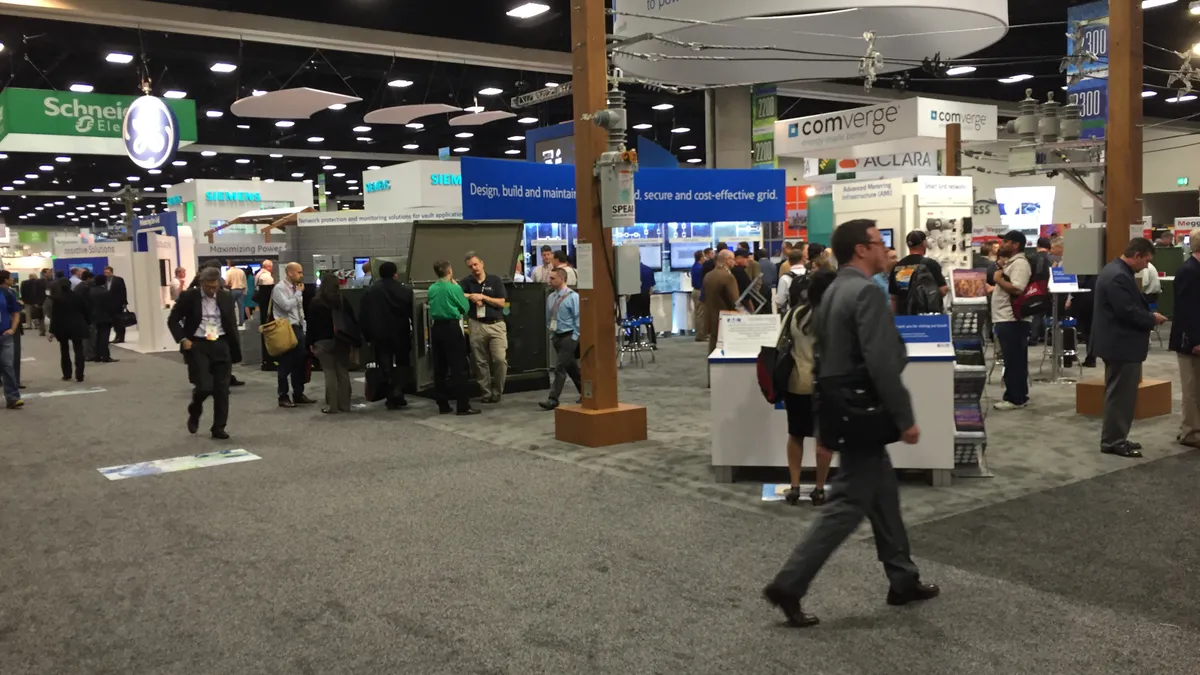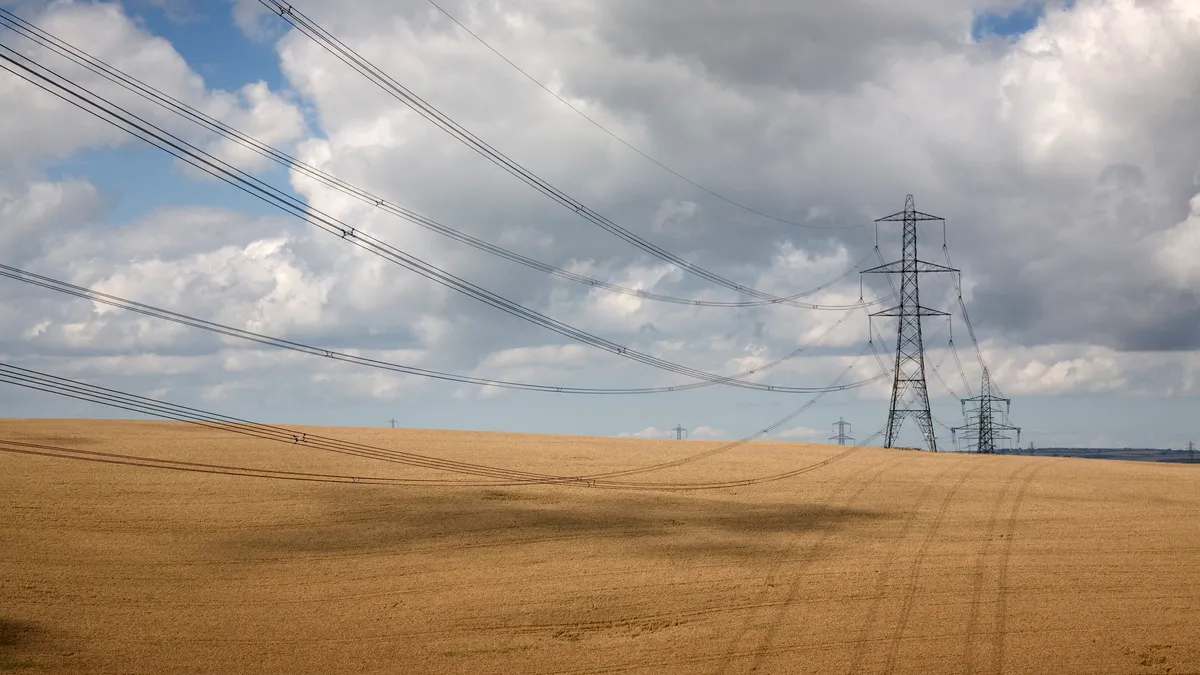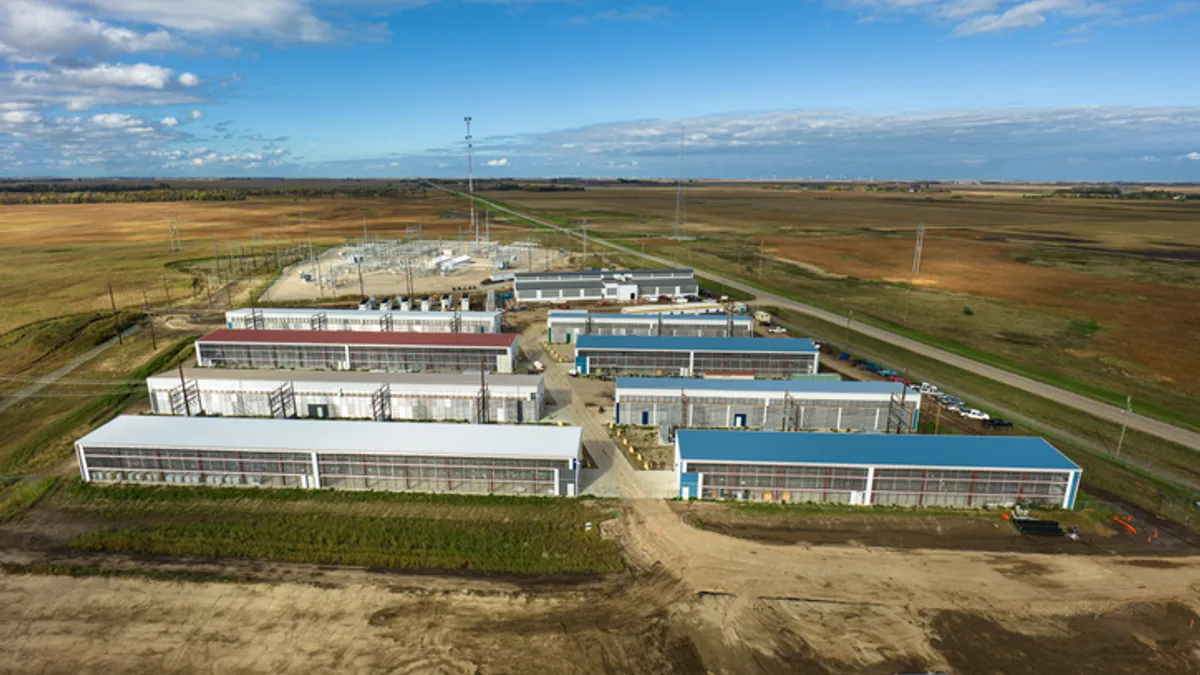The first two days of DistribuTECH 2015 are history. After spending Tuesday hearing the somewhat contrasting perspectives of two California utility CEOs, Utility Dive spent Wednesday wandering the show floor, attending panels, and conducting exclusive interviews.
But the biggest highlight of Wednesday for Utility Dive had little to do with the show itself. San Diego Gas & Electric invited us to its headquarters just outside of the city, where we had a long and wide-ranging interview with SDG&E's senior vice president of power supply. We'll follow up with an in-depth story in the coming weeks, but we've included one highlight from our interview among the DistribuTECH coverage below.
The show wraps up Thursday, but that doesn't mean that Utility Dive will stop reporting. If you're interested staying up-to-date on the conference in real time, you can follow Utility Dive's editors on Twitter at @davide_savenije and @GavinBade. And if you're here in San Diego and want to talk, shoot us an email.
Here are the highlights from Day Two, followed by a list of announcements made at the show. We'll have the third and final piece of daily DistribuTECH coverage for you Friday.
Duke Energy's 'coalition of the willing:' Can the utility build, operate, and service microgrids?
Gavin Bade: Last year at DistribuTECH, Duke Energy announced the launch of its “Coalition of the Willing,” a collaborative project with vendors, telecommunications companies and technology businesses aimed at integrating technologies at the grid edge. One year later, that coalition has grown from six to 25 companies working with Duke.
The point? To devise uniform standards for different grid edge technologies to enhance grid reliability, detect problems and integrate more renewables and distributed energy resources. And the best way to do it? Build a microgrid from the ground up.
Utility Dive briefed the finer points of the program Wednesday, but we then had the chance to speak with Jason Handley, director of smart grid emerging technologies and operations at Duke. He said the utility wants to build a microgrid not only to figure out how to integrate countless different devices and grid gadgets, but to also test the waters for microgrid ownership.
“We’re losing kWh to decreased demand, so there’s got to be other ways that we start to look at to make money, because we are still a shareholder-owned company,” he said.
But while new business models are always exciting, he said ownership conversations are still years away.
“For us, the first thing is to get interoperability more well known in the industry and to get a standard around it,” Handley said. “The second thing is really to see is if we can build, operate, and service a microgrid by ourselves.”
If Duke and its partners are successful in building the microgrid, it could help set a new precedent for who should own and operate microgrids across the nation. Traditionally, third parties have done this, but utilities are starting to stick their toes in the water.
“The biggest thing for us is [the microgrid] has to have seamless interaction with the grid, and there can only be one master,” Handley said. “Everybody’s got to understand who’s in control between the grid and the microgrid, and my guys at Duke, we always want to be in control of that.”
It makes theoretical sense for utilities to be in the microgrid business, Handly continued, because they have decades of experience operating the larger grid.
“For third-party microgrids, we think we can add a lot to it because we know how to operate grids and have been doing it for years,” he said.
Handley was quick to add, however, that Duke is not trying to “run the industry” with this initiative. It is much more interested in collaboration than competing with other utilities or third party providers at this juncture.
“We’re not saying we want everyone in the industry to do something like this,” he said. “The 'Coalition of the Willing' is an idea, and we want feedback.”
Duke wants its new microgrid test facility to be operational by the third quarter of this year, and installations at the site will begin this month. The goal is to come back to DistribuTECH 2016 with the ability to demonstrate live interoperability on the microgrid.
“We know this is coming, let’s put it that way,” Handley said. “We know someone is going to do this in five, 10 years — whenever the cost structure gets better. Why not us?”
Sunverge: Next big innovation in distributed energy has nothing to do with technology
Davide Savenije: When CEO Ken Munson and CTO Dean Sanders founded Sunverge in 2009, they saw an opportunity emerging around renewables integration.
"What we saw was that the industry's challenges were being presented as discrete components," Munson told Utility Dive in an interview on Wednesday. "A lot of smart inverter technologies were saying we can solve the problem with a smart inverter, and a lot of battery companies were saying, well, we can theoretically solve it with just a battery. A lot of software companies were saying, we can solve it with a piece of software."
"It's our belief that that was actually one of the industry barriers," Munson continued. "The fact [is] that it's not a discrete technology by itself that's going to solve [these challenges], it's ... the unified approach and using those components in concert to actually solve the problem."
That may be an opportune perspective for a company whose product is an energy management system for distributed resources, but many utility executives share a similar view. They, like Munson, aren't interested in picking a winning technology or vendor. Many believe the killer application for the smart grid isn't any single technology, but the integration of a fleet of technologies that, working together, can help manage the grid and the influx of new technologies.
The value for utilities is to be able to command and control this fleet of distributed assets, Munson said. Sunverge believes it has built a platform that enables the integration of new technologies, particularly distributed solar plus storage.
The question facing utilities today is not about whether the technology works, Munson said. "I believe the market has moved beyond experimentation. ... Batteries have been proven."
"What's interesting is," he added, "where there was a headwind three years ago, four years ago, now there's no wind — maybe even a slight tailwind where the industry is starting to come around to the benefit."
The real question facing utilities is something the industry can't stop talking about: business model, business model, business model.
"We're now in the situation where [utilities are asking], how do you make money in this? Who owns this asset? How do we work with regulators? How do we work with the channel installers? How do we work with local areas of jurisdiction to improve their understanding so we can streamline the interconnect process?" Munson said. "All of these are important discussions that are emerging now, versus does this battery charge or discharge?"
"Across all the projects we have around the world, there [are] probably two dozen different types of ownership models that are really being played out," Munson said.
Asked if there a proven ownership model for utilities out there, Munson quickly replied, "No. Not in my opinion."
"That's the next wave of innovation in the industry — what these business cases [are] and how these business cases evolve into different, non-standard ownership models," he said.
HECO and DTE's distributed storage pilots
Gavin Bade: Energy storage is on every utility’s mind these days, so Utility Dive wasn’t too surprised when we had to sit on the floor off to the side because all the seats were already taken at the distributed storge panel at DistribuTECH. When we arrived, Hawk Asgeirsson, manager of power systems and technology at DTE Energy, was talking about his company’s storage pilot project.
DTE currently has 18 batteries installed in its service area for about 1 MW of storage and is studying how to best integrate them onto the grid. 17 of the batteries are on a single circuit, Asgeirsson said, and two of them are repurposed automotive batteries from Fiat 500s. The batteries are used predominantly for peak shaving in Michigan, a state where DER penetration is still relatively low.
Demonstration projects like this are essential to “get the bugs out,” Asgiersson said. Last year’s punishing Michigan winter posed some problems for the batteries — issues that Asgiersson said have been largely solved and not proved problematic this winter. He said that DTE assumes a 10-year battery life when it plans storage projects, and that the pilot will be completed by the end of the year.
Dora Nakafuji from Hawaiian Electric (HECO) was up next to talk about HECO’s distributed storage project for commercial and industrial customers. The utility system peaks in the evening, she explained, so there’s not so much a Duck Curve in Hawaii as there is an Elephant Curve, with the evening peak looking like a trunk. But Hawaii’s abundant solar resources generate most in the middle of the day, making storage solutions paramount for HECO.
That’s why, back in September, HECO announced it was partnering with Stem for a 1 MW solar-plus-storage pilot for C&I customers. The utility is currently gearing up to install Stem batteries for 20-30 customers beginning next month, and participants will be able to tailor their battery’s output to meet their power needs through a mobile app. The hope is that the pilot will demonstrate how storage can help customers make better use of their solar installations. Nakafuji is optimistic about the prospects for storage in Hawaii, as the state’s high power prices enhance the value proposition of batteries.
New York utilities and grid operators talk REV
Gavin Bade: In the afternoon, Utility Dive attended a panel discussion with New York energy leaders about the state’s aggressive grid reforms. If you’re not familiar with REV (Reforming the Energy Vision), take a moment to read Utility Dive’s interview with Audrey Zibelman, New York’s chief utility regulator and one of the forces behind the reform. The crux of the program is to create a distribution system platform that both utilities and third parties can build on to enhance reliability, integrate renewables and support DERs.
Stuart Nachmias of Con Ed told the audience that REV presents an opportunity for a holistic review of the entire transmission and distribution system. In his utility’s view, both third parties and utilities should have the opportunity to own behind-the-meter resources, and the REV proceedings are paving the way to a market structure where that can happen.
Ken Daly of National Grid agreed, but stressed that it’s still the early stages. In a Super Bowl metaphor, he told the crowd that we’re on the one yard line with REV, but in this case still have 99 yards to go, and we’ll have to “run the ball before we throw.” He touched on a number of National Grid programs aimed at animating the distribution system, like its partnerships with Clarkson University on microgrids and Buffalo Niagara Medical Center on electric fleet vehicles and chargers. Every region has different needs he said, so utilities need to be intelligent about how they deploy technology and site pilot projects in REV-era New York.
Next up was the CEO and President of the New York ISO, Stephen Whitley. He outlined three principles for “efficient wholesale market integration of DERs”:
- Dispatchable DERs should be “permitted to participate in all wholesale markets for which they qualify,” as long as they meet reliability standards
- Products and services DERs provide directly to the wholesale system “should be appropriately compensated in the wholesale markets.”
- DERs not in wholesale markets (not visible or controlled), “should, where appropriate be reflected in operational and planning processes.”
“Markets are what really drive innovation,” Whitley said during the question and answer section, and what New York lacks for things like energy efficiency is functioning markets. REV hopes to change all that with the distribution system platform.
But amid the optimism, Jeff Kapsis from Opower brought the audience back to reality. Less than 1% of New Yorkers have participated in an energy efficiency program, less than 2% have smart thermostats, and 0.4% have rooftop solar (there was some contention about the numbers, with Nachmias pointing out that Con Ed has enjoyed success with C&I efficiency and DR programs). The point, Kapsis said, is that there is a long way to go.
The hope is that REV will align utility and vendor business models with scaling up DERs, and expanding efficiency and DR programs, he continued, but there are some key questions. The biggest is likely whether the state will undertake some sort of performance-based rate reform, but the panel couldn’t settle on a rate structure they found most amenable.
During the question and answer section, Daly told the audience that National Grid is not looking to be a major owner of distributed solar, “but in very selective cases it could be beneficial,” he said. Utilities can help spread to solar to folks who either cannot afford it or do not have suitable rooftops through community solar programs and other initiatives, he said.
Another questioner asked NYISO’s Whitely what the biggest change for a grid operator is under REV. Whitley responded that the biggest challenge is how to forecast demand with more DERs, energy efficiency and demand response under the new regulatory regime.
The panel ended on a light note when the final questioner asked the panel whether he should invest in third party providers in New York or the big utilities. It’s not a zero sum game, the panel concluded. As REV opens up new distribution markets a lot of wealth will be created for both vendors and utilities, so everyone should just buy both, they said.
SDG&E's problem with rooftop solar
Davide Savenije: San Diego Gas & Electric has about 45,000 rooftop solar customers today spread across its service territory, and that number is growing between at a rate of 4-5% per month, James Avery, senior vice president of power supply told Utility Dive in an interview.
The problem for SDG&E is that those customers are incentivized to use solar in order to avoid using energy from the grid. But that's not aligned with the needs of a grid system that's struggling with a growing gap between between average demand and peak demand, according to Avery.
For most rooftop solar systems, maximum output occurs during the middle of the day — precisely when SDG&E's demand is low. Solar output declines dramatically in the evening — exactly when the utility's demand ramps up to its daily peak. Solar customers are thus creating burdens on the system and shifting costs to other customers, particularly low-income ones who can't afford solar, according to Avery.
Customers who don't have the capability to install solar "are paying the price" for the customers who do, he said. A new rate structure (California currently has a four-tiered rate structure) is need to incent the right behavior, Avery argued, because some of the rates actually incent the wrong behavior.
Avery would like to see rates that reflect the true costs of operating the system at any given time. During peaks, the rates should invariably be higher, his thinking goes, while overnight or the middle of the day, the rates should be lower. New technologies will enable customers to take advantage of those rates in the future by, for example, being pre-programmed to charge electric vehicles overnight or use rooftop solar to pre-cool the home during the middle of the day.
California should also incentivize solar installations to face westward, Avery suggested. The overall amount of energy produced will be less, but the value to the grid will be far greater because it will help address the peak.
"If you could give me solar that produced energy at 8:00 pm at night, it would make a big difference where I put it, because then I could put it on heavy distribution circuits that are heavily loaded," Avery said. "But I'm a realist — you're not going to give me solar that produces power at 8:00 pm at night."
"Until you couple solar with energy storage devices, it's not going to be a benefit to the grid," he concluded.
A very short list of announcements
On Tuesday and Wednesday, we compiled long lists of important announcements being made at DistribuTECH 2015. Today, the list is short. Most of the industry players looking to make a splash at the show have already done so.
Here are the most important announcements that didn't make it into our last two lists.
Editor's note: This list is not comprehensive — it's inevitable that we missed something. If you have an important announcement you're making at DistribuTECH, but it's not on Tuesday, Wednesday or today's list, shoot me an email at [email protected]. Please include a link to the release.
- Utilidata has announced it will work with Pacific Gas & Electric on a Smart Grid Voltage and Reactive Optimization Pilot Program to help integrate renewables and drive system efficiencies through its Volt/Var optimization technology.
- Bidgely has announced it will work with Commonwealth Edison to deploy its energy disaggregation applications.
- C3 Energy has announced it will provide AEP Public Service Company of Oklahoma with its customer engagement and analytics for residential and small and medium business customers.
- Autogrid has announced it has partnered with Trilliant to integrate its data platform with Trilliant’s smart communications platform. Autogrid also announced a collaboration with Microsoft that enables utilities using Azure to easily integrate Autogrid's platform and applications.






















